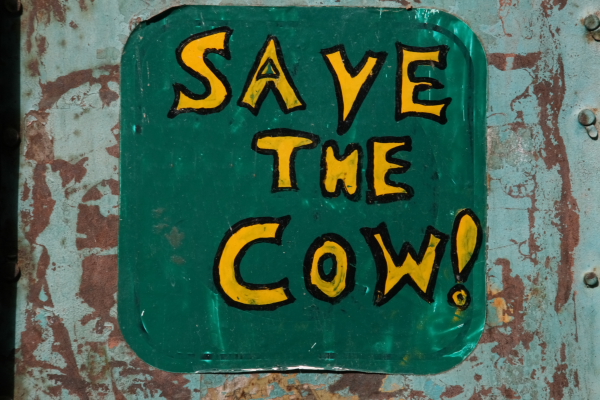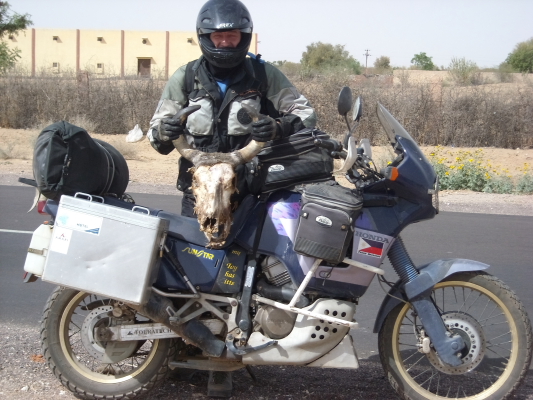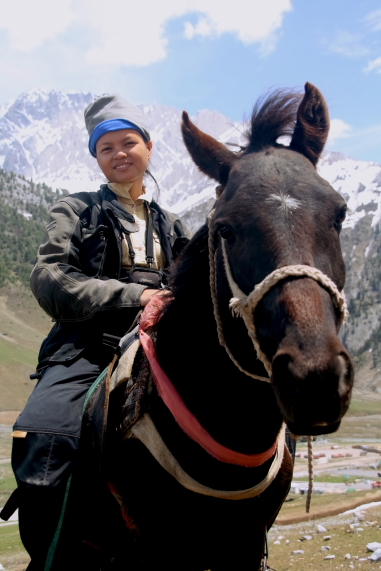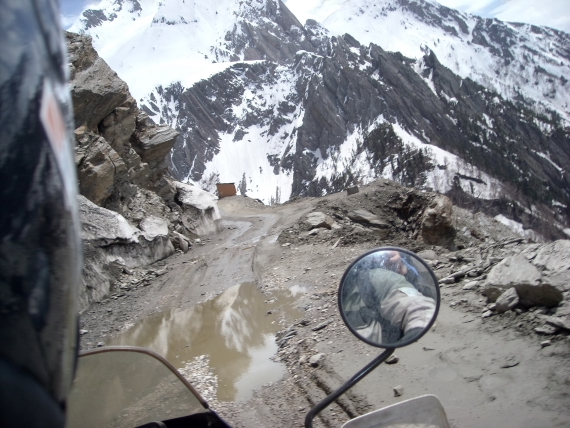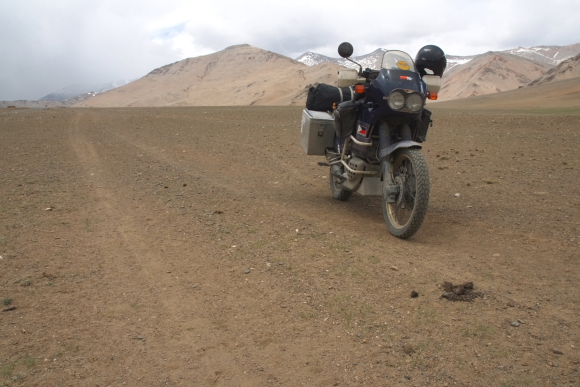India 13.04.09 - 17.06.09
at the TAJ MAHAL
Having a very early start we arrive at the border in Banbassa by 6AM. 50 meters behind Nepali Immigration office the tarmac ends giving way to rough gravel which reminds me of a riverbed
Mostly locals are using horse driven carts moving their personal belongings from one side the border to another. It seems like there is no need for visa or passport for Indian or Nepal nationals.
For us its different obviously. The 2 officers at the Immigration let me sit down and wait till theyre finished with the newspaper and then starting asking me questions Ive been asked thousands of times already: where you from (having my passport), how much is the motorbike, is this your wife, what is your job
Not many tourists passing this way I reckon and the job at this border is more than boring.
It proves again that only the best officers are being deployed in Banbassa when the Customs officer is trying to show me that my passport expires in about 6 months. In fact he is looking at the Indian visa and its expiry date.
Some more soft gravel and more horse carts, then through a narrow dam-bridge and one more gate before we can enter India.
Mid April is too early for any excursions to Ladakh as most of the high altitude passes are still covered with snow. Instead were deciding on a loop around Uttar Pradesh and Rajastan.
Our first target is the magnificent Taj Mahal in Agra. As soon as I see the sun coming up behind the monument I know that it was worth every effort to come and see it what a view!!!
sunrise at the TAJ MAHAL
The roads and the traffic in India are surprisingly easy. Riding within the city limits is still a nightmare but out on the open highway it is by far not as shocking as we heard of
Yes, there will be still vehicles coming head on towards you on a dual carriage way and there will be trucks and busses overtaking each other, leaving no other option for the bike but escaping on to the sandy road shoulder, but this is happening all over Asia so far.
There is lots of road construction going on in India and the congested one lane tracks vanishing in a fast pace. From Agra to Ajmer and Pushkar were riding the brand new dual carriage way with average speed of 100km/h. Whod ever think we would be able to reach 100 in this country?!
at the 54m high gate in fatehpur sikri
As were moving westwards the cows pulling carts are increasingly replaced by camels, the vast wheat fields are giving place to brick businesses and later to sand, sand and more sand. Thats the great Thar Desert.
The countless piles of cow dung along the roads in Uttar Pradesh are vanishing too as we ride to Rajastan. We can still observe people collecting the fresh excrements, forming it into perfect circles and drying it on the roofs but in Uttar Pradesh this is more of an art than necessity. Over there, the fresh fallen paste would be collected and formed by hands (right before making the chapattis
) into forms reminding us of bakery products, dried and then piled up to multi storey cones. The cone would be covered by a thin layer of dung protecting it from heat and erosion, I guess, but leaving an opening to the passing traffic. Some people might be seduced by the great looks and buy some.
Pushkar is well known for its holy lake and for its holy or not so holy men. There are with no doubt some real Sadhus in Pushkar surviving only on meditation, ganja and offerings but we can also observe some Westerners copying the holy men and enjoying the smoke for the time being.
The lake itself is almost dry and what is left of it is not very appealing. Still, the Pilgrims are bathing in it holy water even!
bathing ghats in pushkar
The remains of numerous cremations are landing in the same water and we can observe some kids digging through the mud in the hope of finding some jewellery or even a gold tooth, whatever would not turn into ashes
Being warned upfront by other travellers, we can withstand the temptations of getting a blessing and a pushkar passport from one of the pushy priests. The questionable practise involves tossing flowers into the lake, getting a red string around the wrist (pushkar passport) and paying few Hundreds Rupiahs to the priest and this all is to show respect, as were being said.
jane is getting a henna tattoo
After a few days in Pushkar with its no booze, meat, eggs or kissing policy were heading slowly north to Bikaner and then Amritsar.
in the great thar desert
two desert ships
indias endangered species...
this cow didnt make it!!
We just cant not to stop at the extraordinary Karni Mata Temple in Deshnok. Here the rats are holy and the pilgrims are trying to become blessed by feeding the rodents and kissing the places the rats are sitting on bizarre!
As with any other temple in India were asked to take off our shoes
only here the floor is seriously stained with rat excrement.
the main actors in the karni mata temple
border closing celebrations at the pakistani border
sikhs at the golden temple in amritsar
Skipping the idea of a camel safari due to glowing heat were having a quick look around Bikaner and its beautiful old houses and heading for Amritsar.
Coming closer to Amritsar the traffic is getting increasingly dense until were hopelessly stuck in an endless pilgrimage close to the holiest Sikh temple.
Nothing helps extended use of bikes horn or even pushing with the front wheel is completely ignored. Sweat is running down my body and I suddenly realize that my waterproof motorbike jacket isnt sweat proof
it appears as stain first and soaks my jacket eventually. Were close to heat exhaustion as suddenly the human mass parts.
Were having a quick look around the golden temple and watching the Sikhs dipping their bodies in the holy lake, constantly listening to the transmitted prayers.
athmosphere at the golden temple
Then were taking off for the ultimate spectacle close to Amritsar the border ceremony in Attari. There are already Thousands of Indians as we arrive at the border. All of them ready to push us through the security checks and towards the arena. Its a very big deal for Indians to scream and shout patriotic slogans during the border closing ceremony. They arrive from all over India especially for this show.
Its funny to one point but also the whole program has some negative vibe due to the hatred we can see in many of the faces. The politics made these two nations enemies sad story it is!
market in Mc leod ganj
The heat is driving us north to Dharamsala and Mc Leod Ganj. It is the end of April and there is almost no tourist here, great place for relaxing before riding to Kashmir and Ladakh.
The road from Manali up to Leh is still closed and were deciding to ride up to Srinagar first, then to Leh and to Manali eventually. All the way to Kashmir heavy traffic. Mostly it is cargo trucks but the closer we come to Srinagar the more military trucks are on the road. Also the road signs change as soon as we cross from Himal Pradesh to Jammu and then to Kashmir. Instead of Hindi all the signs appear suddenly in Arabic.
The drivers are becoming increasingly aggressive and overtaking on any blind corner. In one day we see 4 serious accidents and arent surprised at all!
teabreak in the mountains
Coming closer to Srinagar the military presence is getting really overwhelming. Every 100 meters there would be few soldiers in the fields, every 500 meters a serious check post and every 2 kilometres a military base Later, we hear from locals that there are 5 soldiers to every local Kashmiri based in this troubled province. We dont know if this number is correct but we observe that every single soldier is a proud owner of a moustache. There must be a rule in the Indian Army, which prescribes the necessity of this moustache and defines its style. And the rule must be at least 35 years old because the style is somehow stuck in the seventies
The last obstacle before reaching Srinagar is the Jawahar tunnel. This tunnel is made by the Germans in the 1920s and they gave a 40 years guarantee for their job. Now, this guarantee expired about 50 years ago and one can see it The tunnel is in a desolate state, no lights, no ventilation, no exit points, no emergency lane but bumpy and greasy asphalt all the 2,5 kilometres. You just dont want to have a problem in here, especially not if a Indian Tata driver is half a meter behind you, blasting his horn and flashing his lights, ready to run over anything in his way!
shikaras in the dal lake
a different definition of beauty in india
life is a journey - complete it
We are reaching Srinagar safe and sound and spending few beautiful days in this heavily guarded fortress while waiting for the road to Ladakh to be open.
On May 8th the pass is officially open and were the first to cross it. The Zoji La will stay in our memory forever for it was the hardest of all 12 passes weve ridden in Ladakh. We have to cross meter deep ice water due to lack of bridges, ride in the snow storm and cross fresh snow fields. The conditions of this mountain track are just awful at this time of the year!
jane on a pony in sonamarg
zoji la pass is not the easiest to cross
slow climb up the zoji la
brrrrrrrrrrrrrrrrrrrrrrrrrrrrrrrrrrr
Our Ladakh loop includes all the passes along the way and some side trips over the supposing highest motor able pass in the world the Khardung La to Nubra valley and over the 3rd highest the Chang La to the Pangong Lake. According to our GPS the Khardung La isnt exactly as high as the Indians want it to be. They claim its elevation is 5602m but it is only 5375m in fact
still high though. The 2nd highest pass follows on the way to Manali.
The Buddhist Ladakh keeps us for 1 month, partly because there is so much to see and partly because the road to Manali isnt open till the beginning of June.
If were just not visiting some Buddhist monasteries or riding around and enjoying the stunning scenery, were strolling around Leh and enjoying its peaceful mood.
Somehow were not really looking forward to get to Manali.
jane with our new friends in drass
foto break in mulbekh
breakfast with a view in mulbekh
posing at the namika la pass
riding the namika la pass
at the namika la pass
sofar the highest pass - the fotu la
view from the monastery in lamayuru
young novices observing the village life in lamayuru
roads in ladakh
on the way to leh
the magnificent indus river
with wayne in the sandplains of ladakh
thiksey gompa
And were exactly right about this bustling hill town. Well, not completely correct. The traffic jam starts already on the last pass the Rotang La. After escaping the Indian way of life for several weeks in Ladakh the real India caught up with us again. There must be Thousands of Indian tourists up on the pass. In rented Mickey Mouse snow overalls they are trying themselves on skies, quads, horses or snow mobiles or just enjoying the dirty snow while being pushed around in wooden carts. There is enough food and drink stalls to keep the people up here all day and if youre fancy to buy some saffron, there will be a seller on spot
It takes some time to pass this busy place and were more than eager to pass it quick. But Rotang La is just the preview of Manali. Here again, traffic jam everywhere, and everywhere the ignorant and disrespectful Indian drivers. Only full brakes and swerving to the side prevents us from having two accidents within shortest time.
Weve had enough of India and for now we want to reach our next country Pakistan, as soon as possible.
riding the khardung la
khardung la in may
riding to nubra valley
the supposingly highest motorable pass in the world
camping out in the nubra valley
on the way to the pangong lake
the 3rd highest pass in the world
lots of snow and ice on the pass
more ice
the scenery on the way to pangong
sand
the road is not always a pleasure
our camp at the pangong lake at 4300m
that must be the most beautiful lake for me sofar
us chilling at the lake
long shadows
back at the chang la pass
riding back to leh
ladakhi plains close to pang
jane with our hosts in pang
just us
johns oilfield loosing its carrier
and this is how to repair it
ways through the snow








